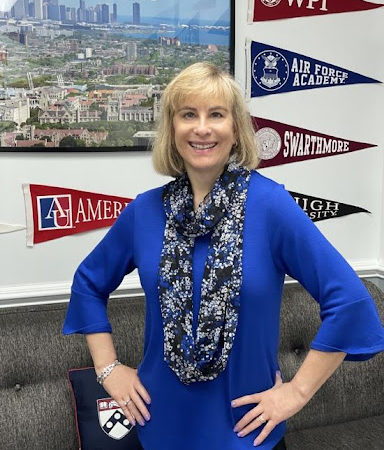
Laurie Kopp Weingarten is a Certified Educational Planner and the Co-Founder of One-Stop College Counseling where she helps students in grades 8-12 navigate the college admissions process. She enjoys helping students identity their “best fit” colleges.
Here is what Laurie had to say when we asked her about best practices for navigating the college application process:
GenHERation®: What is the Common Application and how can students access it?
Laurie Kopp Weingarten: The Common Application has over 900 member colleges that students can choose to apply to—so many options! Students complete the basic information asked on the application, add a personal statement, list their activities and honors, and then they can submit that application to all their colleges. Some colleges may ask for additional information or essays in the application platform, but students don’t have to retype or reenter any of the “common” information, including their main essay. They can apply to a total of twenty schools using the Common App, which is more than sufficient!
GenHERation®: What are the differences between Early Decision, Early Action, Rolling Admission, and Regular Decision?
Kopp Weingarten: Early Decision (ED) is a plan where students apply early to a college (the most typical deadlines are 11/1 or 11/15) and they receive their results in mid-December. When applying ED, the student, their parent(s), and their high school counselor sign an agreement stating that if the applicant is accepted, they will attend the university. Not only is the student bound to enroll, but they need to remove all their other outstanding college applications. By entering into an ED agreement, the student typically increases their chances of acceptance to that college. If the student is not accepted into their ED school, they can select another college that offers Early Decision 2, a second binding round. Again, they would all have to sign an agreement that the student would attend if admitted.
Another option is Early Action (EA). Like Early Decision, students apply early and will hear back earlier than the Regular Decision applicants, but the decision is not binding. Accepted students have until May 1st to decide whether they want to go to that college or not.
There is also a plan called Rolling Admission. Admission officers review the applications as they are submitted and provide decisions in the order received. We love Rolling Admission schools, but there aren’t a lot of colleges that offer those plans!
Regular Decision (RD) is the most competitive round because there are so many applications being considered for admission. If students can get accepted in the early rounds, they may not be as stressed as those waiting for the RD decisions. Applicants often increase their chances of admission and merit scholarships when applying Early Action or Early Decision.
GenHERation®: While many colleges and universities have become test-optional, do you think it is advantageous for students to still take the SAT/ACT?
Kopp Weingarten: The test-optional movement began in 1969 at Bowdoin College. Pre-COVID-19, the number of colleges offering a test-optional plan was growing each year, and by March 2020, there were already 1,080 colleges that were test-optional or test-flexible. The number increased rapidly during the pandemic as COVID-19 restrictions prevented students from being able to sit for the SAT or ACT at testing centers. If a college states that they are test-optional, they mean it. Applicants do not need to submit their scores. However, I do encourage students to take the SAT and ACT, and I recommend that they study for the exam over the summer when they have more free time (the summer after sophomore year is often the optimal time to study). If they do well on the exam, they should submit the results. If they do not perform well, they can choose to apply under the test optional plan. Another testing policy to be aware of is the test-blind policy, which is being used at the University of California schools as well as at some other colleges. A test-blind policy means that the college will not review any ACT/SAT results.
GenHERation®: What are the differences between the resume and the activities list when it comes to completing the college application?
Kopp Weingarten: Most colleges do not require students complete a resume, but the honors and activities lists are a mandatory part of the Common Application. Students should include any honors and awards they have earned, and they should list their activities, highlighting leadership roles, community service involvement, and employment. They don’t need to fill in all 10 spaces provided, but they should include their biggest accomplishments and highlight their roles in each activity. The number of characters allowed is limited, so it’s important to choose their words carefully. If the college allows a resume submission, then students can use the resume to add items that did not fit on the activities list.
GenHERation®: How can high school students craft an effective resume?
Kopp Weingarten: On average, a college admissions officer will spend several minutes reviewing each application. The resume needs to be clear and concise, so it can be read quickly. If students want to highlight their creativity, they can compose a more creative resume. This type of resume might be best for students who are applying to a summer internship or planning to major in the arts, theater, or drama. One student I worked with used a creative resume to apply to an internship with a focus on design. That proved to be successful because she was able to highlight her creativity by crafting a unique resume template.
GenHERation®: What are your best tips and tricks for crafting the activities list?
Kopp Weingarten: The activities section is a vital component of the Common Application. Colleges are interested in seeing how students spend their time outside of the classroom as admission officers want to know how the applicant will contribute to the college’s campus community. Students can include up to 10 activities on their list. It is important to list the most important activity first. This is typically an activity that occupies several hours per week and one that a student has been involved in for multiple years. There are only 150 characters allocated to discuss the student’s leadership and impact in the activity, so it is important to be concise. Students will be asked to indicate if they participated in each activity during the summer, during the school year, or year round. It’s essential not to overstate how many hours per week were spent on an activity.
For the Honors Section, college admissions officers are looking for academic honors, including art and music. Students are only allowed to list five honors, so they should choose awards that add depth to their application. Of course, many students do not have five honors to show, and that is okay!
GenHERation®: Who should you ask for recommendation letters, and what is considered proper etiquette when reaching out to potential recommenders?
Kopp Weingarten: Students should ask two teachers in their core classes (English, math, science, history/social studies, and foreign language). They can also often add a supplemental recommendation letter from an employer or coach. Most colleges will request a counselor recommendation letter too. Applicants should contact the teachers they selected in May or June of their junior year and ask if they can write a favorable recommendation. If a teacher hedges or doesn’t seem enthusiastic about writing on their behalf, students should politely say, “Thank you,” and choose somebody else. It is important for the teacher to be able to highlight the applicant’s skills, accomplishments, character, and potential. I encourage students to arrange to meet with the teachers that will be writing their recommendations, so they can discuss what they loved about the class, how they contributed, and what their future college plans entail. Most importantly, applicants should remember to thank their teachers for their support and advocacy once accepted into college.
Laurie Kopp Weingarten is a Certified Educational Planner and President of One-Stop College Counseling. Laurie attended The Wharton School of the University of Pennsylvania, where she graduated summa cum laude and was elected to Phi Beta Kappa. She worked in marketing for several Fortune 500 corporations, until she decided to pursue an MBA at Harvard Business School. In 2012, Laurie co-founded One-Stop. In her role as Chief Educational Consultant, Laurie guides students through each stage of the college admissions process. She is passionate about helping students reach their full academic and extracurricular potential; there is nothing more rewarding than their look of elation upon acceptance to their top choice schools! Awarded the CEP by the American Institute of Certified Educational Planners (AICEP), Laurie has been recognized for achieving the highest level of competence in her field. She has been regularly featured in numerous newspapers and publications including The New York Times, The Wall Street Journal, Forbes, USA Today, and Inside Higher Ed. Laurie is also a professional member of the Independent Educational Consultants Association (IECA), and a member of the Higher Education Consultants Organization (HECA) and the National Association for College Admission Counseling (NACAC).



Comments (0)